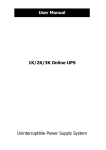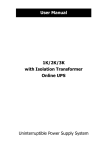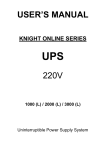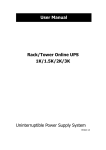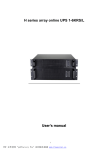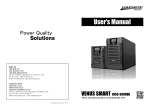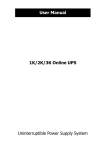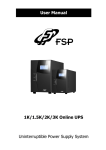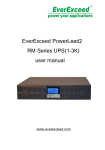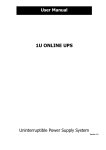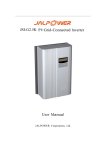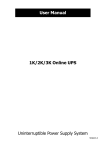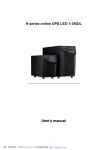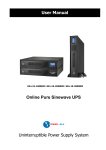Download USER`S MANUAL 220V
Transcript
USER’S MANUAL KNIGHT ONLINE SERIES UPS 220V 1000 (L) / 2000 (L) / 3000 (L) Uninterruptible Power Supply System Contents 1. Safety Warning.......................................................................................................................1 1-1. Transportation .................................................................................................................1 1-2. Preparation .....................................................................................................................1 1-3. Installation.......................................................................................................................1 1-4. Operation ........................................................................................................................1 1-5. Maintenance, service and faults......................................................................................2 2. Installation and setup .............................................................................................................3 2-1. Rear panel view ..............................................................................................................3 2-2. Setup the UPS ................................................................................................................3 3. Operations..............................................................................................................................5 3-1. LCD Panel ......................................................................................................................5 3-2. Button Operation.............................................................................................................5 3-3. Audible Alarm ..................................................................................................................7 3-4. LCD display wordings index............................................................................................7 3-5. UPS Setting ....................................................................................................................7 3-6. Operating Mode Description .........................................................................................10 3-7. Faults Reference Code ................................................................................................. 11 3-8. Warning indicator ..........................................................................................................12 4. Troubleshooting....................................................................................................................13 5. Storage and Maintenance ....................................................................................................14 6. Specifications .......................................................................................................................15 1. Safety Warning Please comply with all warnings and operating instructions in this manual strictly. Save this manual properly and read carefully the following instructions before installing the unit. Do not operate this unit before reading through all safety information and operating instructions carefully 1-1. Transportation Please transport the UPS system only in the original package to protect against shock and impact. 1-2. Preparation Condensation may occur if the UPS system is moved directly from cold to warm environment. The UPS system must be absolutely dry before being installed. Please allow at least two hours for the UPS system to acclimate the environment. Do not install the UPS system near water or in moist environments. Do not install the UPS system where it would be exposed to direct sunlight or near heater. Do not block ventilation holes in the UPS housing. 1-3. Installation Do not connect appliances or devices which would overload the UPS system (e.g. laser printers) to the UPS output sockets. Place cables in such a way that no one can step on or trip over them. Do not connect domestic appliances such as hair dryers to UPS output sockets. The UPS can be operated by any individuals with no previous experience. Connect the UPS system only to an earthed shockproof outlet which must be easily accessible and close to the UPS system. Please use only VDE-tested, CE-marked mains cable (e.g. the mains cable of your computer) to connect the UPS system to the building wiring outlet (shockproof outlet). Please use only VDE-tested, CE-marked power cables to connect the loads to the UPS system. When installing the equipment, it should ensure that the sum of the leakage current of the UPS and the connected devices does not exceed 3.5mA. 1-4. Operation Do not disconnect the mains cable on the UPS system or the building wiring outlet (shockproof socket outlet) during operations since this would cancel the protective earthing of the UPS system and of all connected loads. The UPS system features its own, internal current source (batteries). The UPS output sockets or output terminals block may be electrically live even if the UPS system is not connected to the building wiring outlet. In order to fully disconnect the UPS system, first press the OFF/Enter button to disconnect the mains. Prevent no fluids or other foreign objects from inside of the UPS system. 1 1-5. Maintenance, service and faults The UPS system operates with hazardous voltages. Repairs may be carried out only by qualified maintenance personnel. Caution - risk of electric shock. Even after the unit is disconnected from the mains (building wiring outlet), components inside the UPS system are still connected to the battery and electrically live and dangerous. Before carrying out any kind of service and/or maintenance, disconnect the batteries and verify that no current is present and no hazardous voltage exists in the terminals of high capability capacitor such as BUS-capacitors. Only persons are adequately familiar with batteries and with the required precautionary measures may replace batteries and supervise operations. Unauthorized persons must be kept well away from the batteries. Caution - risk of electric shock. The battery circuit is not isolated from the input voltage. Hazardous voltages may occur between the battery terminals and the ground. Before touching, please verify that no voltage is present! Batteries may cause electric shock and have a high short-circuit current. Please take the precautionary measures specified below and any other measures necessary when working with batteries: - remove wristwatches, rings and other metal objects - use only tools with insulated grips and handles. When changing batteries, install the same number and same type of batteries. Do not attempt to dispose of batteries by burning them. This could cause battery explosion. Do not open or destroy batteries. Escaping electrolyte can cause injury to the skin and eyes. It may be toxic. Please replace the fuse only with the same type and amperage in order to avoid fire hazards. Do not dismantle the UPS system. 2 2. Installation and set up NOTE: Before installation, please inspect the unit. Be sure that nothing inside the package is damaged. Please keep the original package in a safe place for future use. NOTE: There are two different types of online UPS: standard and long-run models. Please refer to the following model table. Model 1K 2K 3K Type Model 1KL 2KL 3KL Standard Type Long-time 2-1. Rear panel view 1K (L) IEC 1. 2. 3. 4. 5. 6. 7. 8. 9. 2K (L) IEC 3K(L) IEC AC input Input circuit breaker USB communication port RS-232 communication port SNMP intelligent slot External battery connection (only available for L model) Output receptacles Output circuit breaker Output terminal 2-2. Setup the UPS Step 1: UPS input connection Plug the UPS into a two-pole, three-wire, grounded receptacle only. Avoid using extension cords. For 200/208/220/230/240VAC models: The power cord is supplied in the UPS package. For 100/110/115/120/127VAC models: The power cord is attached to the UPS. The input plug is a NEMA 5-15P for 1K and 1KLmodels, NEMA 5-20P for 2K and 2KL models. Note: For Low voltage models. Check if the site wiring fault indicator lights up in LCD panel. It will be illuminated when the UPS is plugged into an improperly wired utility power outlet (Refer to Troubleshooting section). Please also install a circuit breaker (40A) between the mains and AC input in 3K model for safety operation. 3 Step 2: UPS output connection For socket-type outputs, simply connect devices to the outlets. For terminal-type input or outputs, please follow below steps for the wiring configuration: a) Remove the small cover of the terminal block b) Suggest using AWG14 or 2.1mm2 power cords. Suggest using AWG12-10 or 3.3mm2-5.3mm2 power cords for NEMA type. c) Upon completion of the wiring configuration, please check whether the wires are securely affixed. d) Put the small cover back to the rear panel. Step 3: Communication connection Communication port: USB port RS-232 port Intelligent slot To allow for unattended UPS shutdown/start-up and status monitoring, connect the communication cable one end to the USB/RS-232 port and the other to the communication port of your PC. With the monitoring software installed, you can schedule UPS shutdown/start-up and monitor UPS status through PC. The UPS is equipped with intelligent slot perfect for either SNMP or AS400 card. When installing either SNMP or AS400 card in the UPS, it will provide advanced communication and monitoring options. PS. USB port and RS-232 port can’t work at the same time. Step 4: Turn on the UPS Press the ON/Mute button on the front panel for two seconds to power on the UPS. Note: The battery charges fully during the first five hours of normal operation. Do not expect full battery run capability during this initial charge period. Step 5: Install software For optimal computer system protection, install UPS monitoring software to fully configure UPS shutdown. Please insert the provided CD into CD-ROM to install the monitoring software. Step 6: External battery connection (for long-time models only) Follow the right chart to make external battery connection. 4 3. Operations 3-1. LCD panel 3-2. Button operation Button Function Turn off the UPS: Press and hold this button at least 2 seconds to turn off the UPS in battery mode. UPS will be in standby mode under power normal or transfer to Bypass mode if the Bypass enable setting OFF/Enter Button by pressing this button. Confirm selection key: Press this button to confirm selection in UPS setting mode. Turn on the UPS: Press and hold ON/Mute button for at least 2 seconds to turn on the UPS. Mute the alarm: When the UPS is on battery mode, press and hold this button for at least 5 seconds to disable or enable the alarm system. But it’s not applied to the situations when warnings or errors ON/Mute Button occur. Up key: Press this button to display previous selection in UPS setting mode. Switch to UPS self-test mode: Press and hold ON/Mute button for 5 seconds to enter UPS self-testing while in AC mode, ECO mode, or converter mode. Switch to bypass mode: When the main power is normal, press ON/Mute + Select ON/Mute and Select buttons simultaneously for 5 seconds. Then UPS Button will enter to bypass mode. This action will be ineffective when the input voltage is out of acceptable range. Switch LCD message: Press this button to change the LCD message for input voltage, input frequency, battery voltage, output voltage and output frequency. It will return back to default display when pausing for 60 seconds. Select Button Setting mode: Press and hold this button for 5 seconds to enter UPS setting mode when UPS is in standby mode or bypass mode. Down key: Press this button to display next selection in UPS setting mode. 5 Function Display Estimated or running time setting and information Remaining backup time. Running time. Remaining backup / Running time in numbers. H: hour, M: minute, S: Second Warning and Fault information Warning occurred. Fault occurred. Codes for warning and fault. Setting operation Indicates that the setting occurs. Mute operation UPS alarm is disabled. UPS information Indicates the input and output voltage, frequency, battery voltage, load information, and internal temperature. V: input/output voltage/ battery voltage, Hz: frequency, %: load level, °C: temperature, KW: active power, KVA: apparent power, A: output current, Mode operation information ONLINE mode. BATTERY mode. CONVERTER mode. BYPASS mode. ECO mode. UPS is charging battery. Load information Load level under 0-25%, 26-50%, 51-75%, and 76-100%. Overload. Outlets with output voltage. Load or UPS output with “short circuit.” Battery information Battery level under 0-25%, 26-50%, 51-75%, and 76-100%. Charger is working. Indicates battery. Battery replacement necessary. Low battery voltage. 6 3-3. Audible Alarm Battery Mode Beeping every 4 seconds Bypass Mode Beeping every 10 seconds Low Battery Beeping every second Overload Beeping twice every second Fault Continuously sounding 3-4. LCD display wordings index Display content Abbreviation Meaning ENA Enable DIS Disable ESC Escape LLS Low loss HLS High loss TP Temperature CH Charger BF Battery fault FU Bypass frequency unstable EE EEPROM error 3-5. UPS Setting Two parameters to set up the UPS: Parameter 2 Parameter 1 Parameter 1: For program alternatives. Parameter 2: Option setting or values for each program. 01: Output voltage setting Interface Setting For 200/208/220/230/240 VAC models, O/P may be chosen as the following: 200: output voltage is 200Vac 208: output voltage is 208Vac 220: output voltage is 220Vac 230: output voltage is 230Vac (Default) 240: output voltage is 240Vac For 100/110/115/120/127 VAC models, O/P may be chosen as the following: 100: output voltage is 100Vac 110: output voltage is 110Vac 115: output voltage is 115Vac 120: output voltage is 120Vac (Default) 127: output voltage is 127Vac 7 02: Converter mode enable/disable Interface Setting ENA: converter mode enable DIS: converter mode disable (Default) 03: Output frequency setting Interface Setting Output frequency can be chosen as the following: 50: output frequency 50Hz 60: output frequency 60Hz 04: Acceptable low voltage setting in Bypass mode Interface Setting Press Down key or Up key to set the acceptable bypass low voltage point(LLS): For 200/208/220/230/240 VAC models: 170-220: low voltage setting point from 170Vac to 220Vac (Default: 170Vac) For 100/110/115/120/127 VAC models: 85-115: low voltage setting point from 85Vac to 115Vac (Default: 85Vac) 05: Acceptable high voltage setting in Bypass mode Interface Setting Press Down key or Up key to set the acceptable high voltage point (HLS) in bypass mode: For 200/208/220/230/240 VAC models: 230-264: high voltage setting point from 230Vac to 264Vac (Default: 264Vac) For 100/110/115/120/127 VAC models: 120-140: high voltage setting point from 120Vac to 140Vac (Default: 132Vac) 06: Acceptable low frequency setting in Bypass/ECO mode Interface Setting Press the Down key or Up key to set the acceptable low frequency point (LLS) in bypass/ECO mode: For 50Hz output frequency models: 45-49Hz: low frequency setting point from 45Hz to 49HZ (Default: 47.0Hz) For 60Hz output frequency models: 55-59Hz: low frequency setting point from 55Hz to 59Hz (Default: 57.0Hz) 8 07: Acceptable high frequency setting in Bypass/ECO mode Interface Setting Press the Down key or Up key to set acceptable high frequency point (HLS) in bypass/ECO mode: For 50Hz output frequency models: 51-55Hz: setting the frequency low loss point from 51Hz to 55HZ (Default: 53.0Hz) For 60Hz output frequency models: 61-65Hz: setting the frequency low loss point from 61Hz to 65Hz (Default: 63.0Hz) 08: ECO mode enable/disable Interface Setting ENA: ECO mode enable DIS: ECO mode disable (Default) 09: Acceptable low voltage setting in ECO mode Interface Setting Press the Down key or Up key to set acceptable low voltage point (LLS) in ECO mode: For 200/208/220/230/240 VAC models, setting range is from -7V to -24V of the nominal voltage. (Default: -12V) For 100/110/115/120/127 VAC models, setting range is from -3V to -12V of the nominal voltage. (Default: -6V) 10: Acceptable high voltage setting in ECO mode Interface Setting Press the Down key or Up key to set acceptable high voltage point (HLS) in ECO mode: For 200/208/220/230/240 VAC models, setting range is from +7V to +24V of the nominal voltage. (Default: +12V) For 100/110/115/120/127 VAC models, setting range is from +3V to +12V of the nominal voltage. (Default: +6V) 9 11: Bypass enable/disable when UPS is off Interface Setting ENA: Bypass mode is enabled when UPS is off DIS: Bypass mode is disabled when UPS is off (Default) 12: Autonomy limitation setting Interface Setting 0-999: backup time setting in minutes from 0-999 for output outlets under battery mode. 0: while setting as「0」, backup time will be on 10 seconds. 999: while setting as「999」, backup time setting will be disabled. (Default) 00: Exit setting 3-6. Operating Mode Description Operating mode LCD display Standby mode Description UPS power off and no output supply power, but still can charge battery. Online mode Input voltage within an acceptable range, UPS provide pure and stable AC power to output, charge the battery under online mode also. ECO mode Energy saving mode: Input voltage within voltage regulation range, UPS will bypass voltage to output for energy saving. Converter mode Input frequency within 40Hz -70Hz, UPS can be set at a constant output frequency, 50Hz - 60Hz. UPS still charge battery under this mode. 10 3-7. Faults Reference Code Fault event Bus start fails Bus over Bus under Bus unbalance Bus short-circuited Inverter soft start fails Inverter voltage is high Inverter voltage is low Inverter output short-circuited Battery voltage is too high Battery voltage is too low Over temperature Over load Battery mode Input voltage is beyond the acceptable range or power failure and alarm is sounding every 4 second, UPS will backup power from battery. Battery test mode UPS will turn off charger, check if battery and DC/DC are normal. Bypass mode Input voltage within acceptable range but UPS is overload, UPS will enter bypass mode or bypass mode can be set up by the front panel. Alarm is sounding every 10 second. Fault mode While a fault has occurred, the ERROR icon and the fault code will be displayed. Fault code 01 02 03 04 05 11 12 13 14 27 28 41 43 11 Icon x x x x x x x x x x x 3-8. Warning indicator Icon (flashing) Warning Alarm Low Battery Sounding every second Overload Sounding twice every second Battery is not connected or Sounding every second Battery Replace Sounding every second Over Charge Over temperature Sounding every second Charger failure Sounding every second Battery fault Sounding every second Out of bypass voltage range Sounding every second Bypass frequency unstable Sounding every second EEPROM error Sounding every second 12 4. Troubleshooting If the UPS system does not operate correctly, please solve the problem by using the table below. Symptom No indication and alarm even the main is normal. The icon and flashing on LCD display and alarm is sounding every second. Fault code is shown as 27 and alarm is continuously sounding. Fault code is shown as 28 and alarm is continuously sounding. Possible cause AC input power is not Connected well. Check if input power cord firmly connected to the mains. AC input is connected to the UPS output. External or internal battery is incorrectly connected. Plug AC input power cord to AC input correctly. Check if all batteries are connected well. Battery voltage is too high or the Contact your dealer. charger is fault. Battery voltage is too low or the Contact your dealer. charger is fault. UPS overload The icon and is flashing on LCD display and alarm is sounding twice every second. Fault code is shown as 43 and is lighting on The icon LCD display and alarm is continuously sounding. Fault code is shown as 14 and the icon is lighting on LCD display and alarm is continuously sounding. Fault code are shown on the LCD display as 01, 02, 03, 04, 11, 12, 13, 41 with alarm sounding continuously. Battery backup time is shorter than nominal value UPS is overloaded. Devices connected to the UPS are fed directly by the electrical network via the Bypass. After repetitive overloads, the UPS is locked in the Bypass mode. Connected devices are fed directly by the mains. UPS shut down automatically because of overload at the UPS output. Remove excess loads from UPS output. Remove excess loads from UPS output. Remove excess loads from UPS output first. Then shut down the UPS then restart it. Remove excess loads from UPS output and restart it. UPS shut down automatically Check output wiring and if the because of short circuit occurs on connected devices are in short the UPS output. circuit status. UPS internal fault occurred. Two possible results below, 1. The load is still supplied, but directly from AC power via bypass. 2. The load is no longer supplied by power. Batteries are not fully charged Batteries defect Fault code is shown as 05 on LCD display. At the same time, alarm is continuously sounding and output is cut off Remedy UPS internal fault occurred and BUS is short circuit. UPS internal fault has 13 Contact with your dealer Charge the batteries for 5 hours at least then check capacity. If the problem still existed, consult with your dealer. Contact with your dealer to replace the battery. Consult with dealer. If UPS power on again before repair, the DC/DC mosfet will damage. 5. Storage and Maintenance Operation This UPS system contains no user-serviceable parts. If the battery service life (3~5 years at 25°C ambient temperature) has been exceeded, the batteries must be replaced. In this case, please contact your dealer. Be sure to deliver the spent battery to a recycling facility or ship it to your dealer in the replacement battery packing material. Storage Before storing, charge the UPS 5 hours. Store the UPS covered and upright in a cool, dry location. During storage, recharge the battery in accordance with the following table: Storage Temperature Recharge Frequency Charging Duration -25°C - 40°C Every 3 months 1-2 hours 40°C - 45°C Every 2 months 1-2 hours 14 6. Specifications * Derate capacity to 60% of capacity in Frequency converter mode and to 80% when the output voltage is adjusted to 208VAC. 15

















